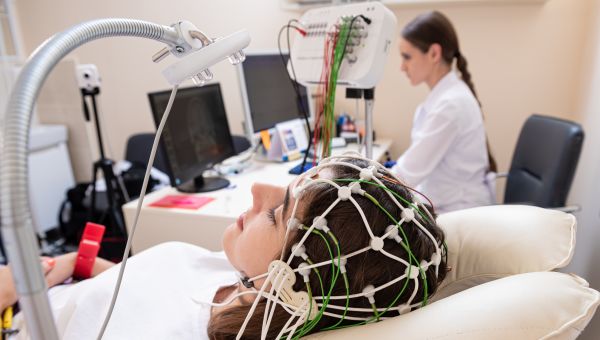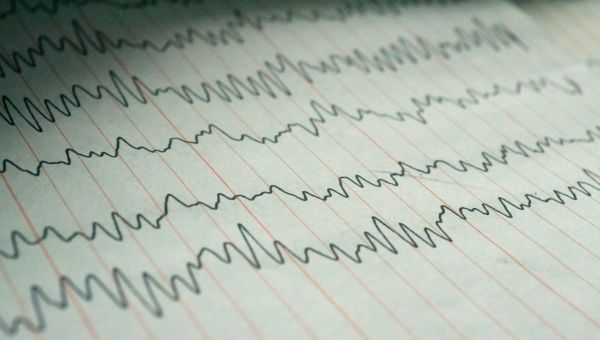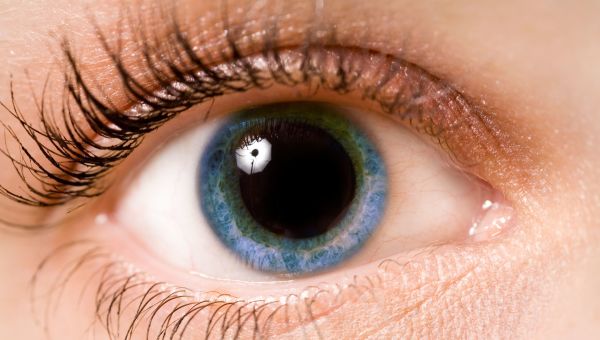What a neurologist wants you to know about epilepsy
Seizures aren't always obvious—and we often don't know what causes them.
Updated on May 7, 2025

About 3.4 million Americans have a seizure disorder, also known as epilepsy, according to the Centers for Disease Control and Prevention (CDC). This number includes both adults and children, as the disorder can affect people very early in life.
Even if you have firsthand experience with epilepsy, you may still have questions about seizures, how the condition is diagnosed,… Show More
About 3.4 million Americans have a seizure disorder, also known as epilepsy, according to the Centers for Disease Control and Prevention (CDC). This number includes both adults and children, as the disorder can affect people very early in life.
Even if you have firsthand experience with epilepsy, you may still have questions about seizures, how the condition is diagnosed, and the ways it can be treated. Here are insights from Lee Dresser, MD, a neurologist in Wilmington, Delaware, about epilepsy.
Show Less
What epilepsy really is
Epilepsy is the fourth most common neurological condition in the United States after migraine, stroke, and Alzheimer’s disease. The term includes a wide range of seizure disorders that can affect people at different ages.
Seizures occur when electrical activity in the brain is disrupted. Since… Show More
Epilepsy is the fourth most common neurological condition in the United States after migraine, stroke, and Alzheimer’s disease. The term includes a wide range of seizure disorders that can affect people at different ages.
Seizures occur when electrical activity in the brain is disrupted. Since cells in the brain communicate using electrical and chemical messages, awareness, behavior, and movement can be disrupted or altered. Seizures may last a few seconds or up to a few minutes.
Seizures can cause a variety of symptoms. For example, during a tonic-clonic seizure—also called a grand mal seizure—patients can have convulsions and shake and may temporarily lose consciousness. During other types of seizures, people may “space out” instead of showing physical signs.
People with epilepsy may experience complications related to the condition, especially if it’s left untreated. They may have difficulty learning new things and have a higher risk of mental health issues like anxiety and depression. During seizures, the odds of injuries and drowning rise. A small percentage of people may experience life-threatening long or continuous seizures, or a condition called sudden unexplained death in epilepsy (SUDEP).
Show Less
There are three main types of seizures
Experts classify seizures into three main types—focal (or partial) onset, generalized onset, or unknown-onset. Their symptoms and effects on the brain and body may differ.
During a focal seizure, one area of the brain is affected. There are two different kinds:
- Aware: the person remains awake and … Show More
Experts classify seizures into three main types—focal (or partial) onset, generalized onset, or unknown-onset. Their symptoms and effects on the brain and body may differ.
During a focal seizure, one area of the brain is affected. There are two different kinds:
- Aware: the person remains awake and aware
- Impaired awareness: the person's awareness is impaired
“Focal seizures can be associated with impaired consciousness or preserved consciousness,” says Dr. Dresser. That means a person may be aware they’re having a seizure, may be confused, or may black out. Focal seizures have a wide array of symptoms. A person can experience unusual smells or tastes, have a strange feeling in their stomach, or feel tingling or twitching in the arms or legs.
During a general seizure, both sides of the brain are affected. There are several different types, including absence, tonic, atonic, clonic, myoclonic, and tonic-clonic seizures. “Most generalized seizures are associated with either loss of consciousness or impaired consciousness,” says Dresser. During a general seizure, a person may lose control of the bowel or bladder, experience difficulty breathing, have stiff or twitching muscles, or flutter their eyes.
With an unknown-onset seizure, the way the seizure began isn’t known. As the seizure type becomes clearer, it may be re-classified into one of the above groups.
Show Less
We don't always know what causes it
Several different medical conditions can cause epilepsy, including a prior stroke, brain tumor, infection, or loss of oxygen to the brain. Epilepsy may also result from a head injury, a genetic disorder, or other neurological disease. In rare cases, epilepsy may be caused by over-activation of… Show More
Several different medical conditions can cause epilepsy, including a prior stroke, brain tumor, infection, or loss of oxygen to the brain. Epilepsy may also result from a head injury, a genetic disorder, or other neurological disease. In rare cases, epilepsy may be caused by over-activation of certain autoimmune diseases.
“A lot of times, those autoimmune-type epilepsies are really resistant to medications but, if treated with medicines that suppress the immune system, the seizures can come under control,” said Dresser.
In many cases, however, a seizure disorder has no known cause. This is called idiopathic epilepsy.
Show Less
Seizures don't necessarily mean you have epilepsy
Not all seizures are associated with epilepsy. For example, having a high fever or low blood sugar can trigger a one-off seizure event, as can stress or lack of sleep in people who are predisposed to having seizures.
“It can be challenging to diagnose epilepsy," Dresser says. "You really have to… Show More
Not all seizures are associated with epilepsy. For example, having a high fever or low blood sugar can trigger a one-off seizure event, as can stress or lack of sleep in people who are predisposed to having seizures.
“It can be challenging to diagnose epilepsy," Dresser says. "You really have to rely heavily on what the patient can tell you or, a lot of times, what bystanders can tell you happened to the person: what the symptoms were, what they experienced, what people saw and what happened after the seizure.”
Neurologists use many different tools to determine where a person is experiencing seizures due to epilepsy. In addition to using computerized tomography (CT) or magnetic resonance imaging (MRI) to take pictures of the brain, they also use an electroencephalogram (EEG) to check electrical activity. Patients with seizure disorders will most likely have disrupted brain activity that can be detected on an EEG.
Research suggests that those with epilepsy have brains that are physically different from those without the disease. More research is needed, but understanding these variations could be crucial to future treatment of the disorder.
Show Less
In most cases, medication works
“The mainstay of treatment for epilepsy is medications,” says Dresser. "Roughly 70 percent of patients can have their seizures completely controlled with medicine."
In cases where medications can't control seizures, patients may have surgery to remove the part of the brain where the seizures… Show More
“The mainstay of treatment for epilepsy is medications,” says Dresser. "Roughly 70 percent of patients can have their seizures completely controlled with medicine."
In cases where medications can't control seizures, patients may have surgery to remove the part of the brain where the seizures originate. This type of procedure is only performed on a small minority of patients. The ketogenic diet, which is very high in fat and low in carbohydrates, may be effective for those who don't respond to medication or choose not to have surgery, particularly children. It can be hard to follow, however.
There are many treatments and interventions in development that can help people whose seizures do not respond to medication, as well. “Researchers are looking at electrical stimulators of the brain, a surgical implanted device, that can actually sense when the seizure is occurring,” says Dresser. "These devices can trigger an electrical stimulus to the brain and try to terminate the seizure quite quickly."
Show Less
You can help a person who is having a seizure
If you witness someone having a seizure, follow these steps:
- If you know that this is the first time the person has had a seizure, call 911 and have an ambulance take them to the emergency room right away.
- If the person is having a tonic-clonic (grand mal) seizure in which they lose consciousness, … Show More
If you witness someone having a seizure, follow these steps:
- If you know that this is the first time the person has had a seizure, call 911 and have an ambulance take them to the emergency room right away.
- If the person is having a tonic-clonic (grand mal) seizure in which they lose consciousness, fall down, and begin moving in a stiff and jerky way, place them on the ground in a safe environment. Remove any sharp or dangerous objects from the area.
- Make sure the person is not in a position where they can hurt themselves or anyone else in the area.
- Turn them on their side.
- Do not place anything at all in their mouth.
- Time how long the seizure lasts. Most end after one to three minutes. Having seizures that last more than five minutes or multiple seizures is an emergency and you need to call 911.
For more information on how to help manage a seizure event—including additional reasons to seek medical help—the CDC and Epilepsy Foundation are good resources.
While it may be scary to witness a seizure, you can help make sure the person stays safe and gets the medical treatment they need as soon as possible.
Show Less
Centers for Disease Control and Prevention. Epilepsy Basics. May 15, 2024.
Epilepsy Foundation. What Is Epilepsy? Accessed May 6, 2025.
Mayo Clinic. Epilepsy. October 14, 2023.
Epilepsy Foundation. Atypical Absence Seizures. Accessed May 6, 2025.
England MJ, Liverman CT, Schultz AM, Strawbridge LM. Summary: a reprint from epilepsy across the spectrum: promoting health and understanding. Epilepsy Curr. 2012;12(6):245-253.
Centers for Disease Control and Prevention. Epilepsy: Types of Seizures. May 15, 2024.
National Health Service (UK). Epilepsy. March 6, 2025.
Epilepsy Foundation. Types of Seizures. Accessed May 6, 2025.
Whelan CD, Altmann A, Botía JA, Jahanshad N, et al. Structural brain abnormalities in the common epilepsies assessed in a worldwide ENIGMA study. Brain. 2018 Feb 1;141(2):391-408.
Epilepsy Society. List of anti-seizure medication. September 2024.
Epilepsy Foundation. Adapting First Aid Plans. January 2022.
Centers for Disease Control and Prevention. Epilepsy: First Aid for Seizures. May 15, 2024.
More On


video


video


video


video
